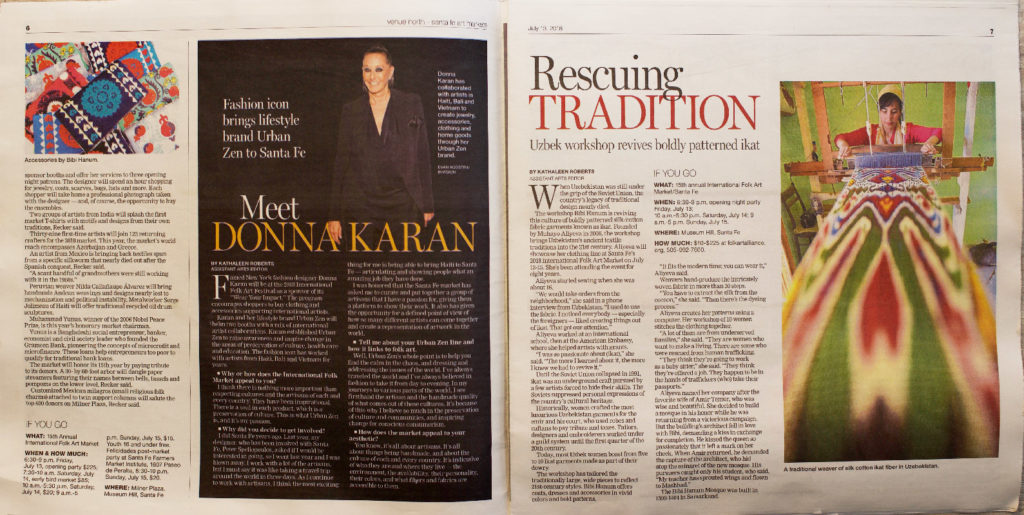
Uzbek workshop revives traditional ikat
By Kathaleen Roberts / Journal Staff Writer
Sunday, July 8th, 2018 at 12:02am
ALBUQUERQUE, N.M. — When Uzebekistan was still under the grip of the Soviet Union, the country’s legacy of traditional design nearly died.
The workshop Bibi Hanum is reviving this culture of boldly patterned silk/cotton fabric garments known as ikat. Founded by Muhayo Aliyeva in 2006, the workshop brings Uzbekistan’s ancient textile traditions into the 21st century. Aliyeva will showcase her clothing line at Santa Fe’s 2018 International Folk Art Market on July 13-15. She’s been attending the event for eight years.
Aliyeva started sewing when she was about 16.
“We would take orders from the neighborhood,” she said in a phone interview from Uzbekistan. “I used to use the fabric. I noticed everybody – especially the foreigners – liked creating things out of ikat. That got our attention.”
Aliyeva worked at an international school, then at the American Embassy, where she helped artists with grants.
“I was so passionate about (ikat),” she said. “The more I learned about it, the more I knew we had to revive it.”
Until the Soviet Union collapsed in 1991, ikat was an underground craft pursued by a few artists forced to hide their skills. The Soviets suppressed personal expressions of the country’s cultural heritage.
Historically, women crafted the most luxurious Uzebekistan garments for the emir and his court, who used robes and caftans to pay tribute and taxes. Tailors, designers and embroiderers worked under a guild system until the first quarter of the 20th century.
Today most Uzbek women boast from five to 10 ikat garments made as part of their dowry.
The workshop has tailored the traditionally large, wide pieces to reflect 21st-century styles. Bibi Hanum offers coats, dresses and accessories in vivid colors and bold patterns.
“It fits the modern time; you can wear it,” Aliyeva said.
Weavers hand-produce the intricately woven fabric in more than 30 steps.
“You have to extract the silk from the cocoon,” she said. “Then there’s the dyeing process.”
Aliyeva creates her patterns using a computer. Her workshop of 10 women stitches the clothing together.
“A lot of them are from underserved families,” she said. “They are women who want to make a living. There are some who were rescued from human trafficking.
“They think they’re going to work as a baby sitter,” she said. “They think they’re offered a job. They happen to be in the hands of traffickers, and they take their passports.”
Aliyeva named her company after the favorite wife of Amir Temur, who was wise and beautiful. She decided to build a mosque in his honor while he was returning from a victorious campaign. But the building’s architect fell in love with Bibi, demanding a kiss in exchange for completion. He kissed the queen so passionately that it left a mark on her cheek. When the Amir returned, he demanded the capture of the architect, who hid atop the minaret of the new mosque. His pursuers caught only his student, who said, “My teacher has sprouted wings and flown to Mashhad.”
The Bibi Hamum Mosque was built in 1399-1404 in Samarkand.







